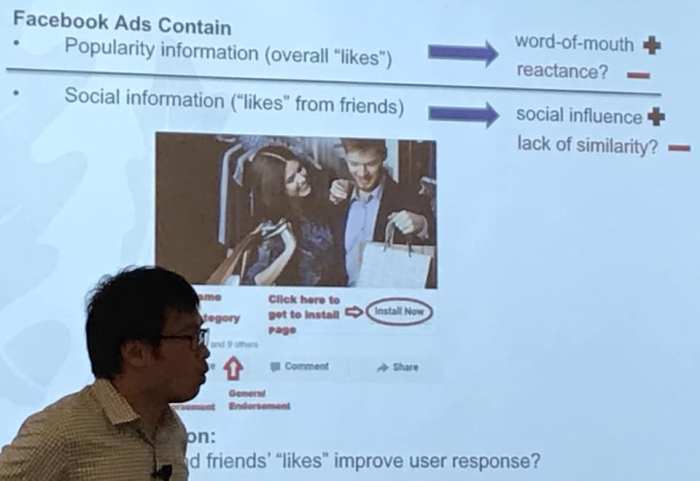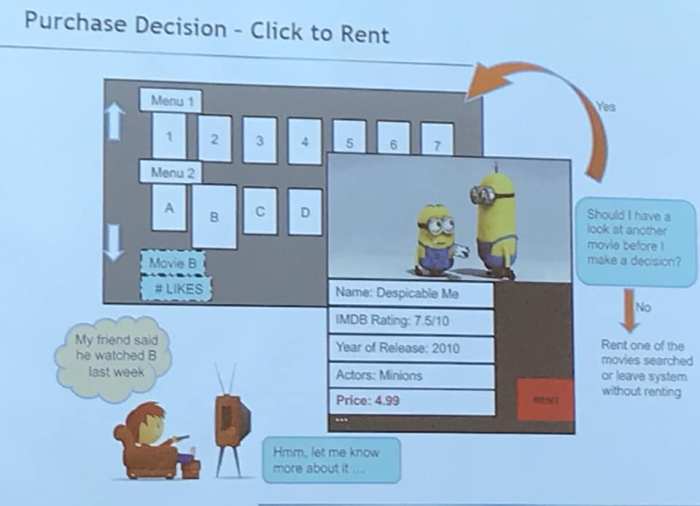Yesterday afternoon’s session at MIT’s Conference on Digital Experimentation (CODE) got some unexpected fireworks from seemingly contradictory findings on ‘Social Media ad Digital Communities’. The first presentation showed ‘The Adverse Effect of “Likes” and Friends “Likes” on Facebook Ads[1]’, while the second showed their positive effects on Movie site Search and Purchase[2]. So does showing friends ‘ likes hurt or help consumer response to your brand’s advertising?

You may ‘like’ a bit more background before answering that question. The first paper studied how click through rate and installation of a mobile shopping app, changed with displaying the number of likes, and specific likes by friends of the Facebook user in the ad. The results show a significant negative impact of either display, but a positive interaction effect (suggesting that giving information from both sources together reduces the negative impact). These findings replicated for a gaming app, where the negative effect was also less strong when the displayed friends were more similar to the Facebook user. Replication in an M-Turk experiment showed similar negative effects, but now a positive impact of showing likes by similar friends.

The second paper studied a dedicated movie rental site, where users either see or don’t see the number of overall likes and whether a friend liked it. The outcome variables are (1) search for the movie, which results in the user watching a trailer, and (2) movie purchase (rental). Friends’ likes positively affect both user decisions, especially when the movie price is high. In contrast, the overall number of likes only affects purchase, not search, and only when the movie price is low. Again, an M-Turk experiment with a ‘pretend’ social network, replicated the results. So which of those 2 studies is most relevant for your brand?

So what is the answer? As all my students know, it starts with ‘It depends’. But on what? In my opinion, it is related to the ‘content separation’ and ‘content integration’ distinction between being interrupted in your goals by an ad versus being aided in your goals by an ad [see presentation with below pic] . In the case of Facebook, my goals may include connecting with friends, getting entertained, learning about politics and getting into fights over it with strangers [see Battle of the Brand Fans blog]. So brand ads typically interrupt my pursuit of such goals, and activate my reactance, as Shun-Yang Lee proposes as an explanation for the adverse effects. We don’t like being told what to do, and view the inclusion of friends’ likes as a manipulation attempt. As a result, we are less likely to click on the ad and to install the advertised app.

In contrast, movie site users are at this moment considering which movie to watch – otherwise they would not be on the site. Showing which of my friends liked the movie, is information relevant to my goal. That distinction is to me a key condition for whether I appreciate the likes information or not. In contrast, the authors’ title ‘Experience Goods’ implies it has something to do with the product/service being advertised, and that the positive effect may not hold for ‘Search Goods’, i.e. for which quality is easily assessed before purchase. Such product distinction is important for allocating marketing budgets to offline, and online paid versus owned media [see link], but I don’t think it is for this question. Therefore, I predict that their results would hold up for search goods, such as TVs or cameras, as long as you advertise them on a website where the consumer specifically comes to look for that purpose (e.g. price comparison sites).
What do you think?
[1] Authors Shun-Yang Lee (UConn, presenting in the pictures), Ashish Agarwal and Andrew Whinston (UT Austin)
[2] ‘The Interplay of Information from Friends and from the Crowd to Search and to Purchase Experience Goods: Results from an Observational Study and form a Randomized Control Trial’ by Baojiang Yang, Miguel Godinho de Matos and Pedro Ferreira, all at Carnegie Mellon University.
Feedback from Pedro Ferreira (Second study presenter): ‘My understanding is that he finds heterogeneous effects, the signal from some friends is positive whereas the signal from some friends is negative. I find also find heterogeneous effects depending on the search vs. purchase stage, price and potential valence of the signal. The settings are not really comparable, he uses facebook, I use a video-on-demand system. My work focuses on close friends, where a positive signal is more likely to emerge. His work looks at all friends, and, even in his own words, people have a long tail of friends in facebook whose signals might not really matter. In the end, it all depends on the level of heterogeneity in the population and on how badly people want to differentiate from their friends.’